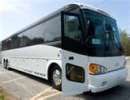
NHTSA Proposes Lap/Seat Belts in All New Motorcoaches
The proposed rule would require them for each passenger seat and the driver's seat on passenger buses and large school buses. Comments are due by Oct. 18 on the rule, which would not require retrofitting buses now in service.
The National Highway Traffic Safety Administration proposed Wednesday to require lap and shoulder belts for each passenger seat and the driver's seat on all new passenger buses and large school buses. Comments are due by Oct. 18 (www.regulations.gov, Docket No. NHTSA-2010-0112) on the rule, with a proposed compliance date that would be three years after publication of a final rule. The proposal would amend the federal motor vehicle safety standard on occupant crash protection (FMVSS No. 208) and is intended to prevent ejection of bus occupants in a crash or rollover.
As many as eight lives would be saved and 794 injuries prevented by use of lap/shoulder belts in the 2,000 new motorcoaches that are sold each year, NHTSA predicts.
Adding lap/shoulder belts is expensive; the proposal estimates the total cost of adding belts, changing the anchorages, and reinforcing the floor of a 54-seat passenger bus is about $12,900,and this does not include higher fuel costs from the added weight of up to 9.95 pounds per two-person seat.
NHTSA did not propose requiring that the estimated 29,325 motorcoaches already in service be retrofitted with a lap/shoulder belt system because of the expense -- an estimated range from $175,950,000 to $997,050,000 for the industry, which it says logged almost 750 million passenger trips in 2007, citing American Bus Association data. "Retrofitting used motorcoaches may not be structurally viable for many motorcoaches and may not be economically feasible for many motorcoach for-hire operators, many of which are small businesses," NHTSA said in the proposed rule's preamble. It added, however, that answers to retrofit questions in the preamble "will aid us in determining whether the agency's initial assessment of cost per equivalent lives saved is correct. The comments will help us determine whether we should issue a separate supplemental NPRM (SNPRM) to require retrofit."
NHTSA's Fatality Analysis Reporting System (FARS) data indicate there were fewer than 10 motorcoach fatalities annually in 1991-1997, but several major individual crashes killed more than 10 people in subsequent years. A 1999 crash near New Orleans killed 22 passengers, while 14 passengers and the driver died in a 2004 crash in Arkansas when the coach hit a highway signpost. The bus fire near Wilmer, Texas, during evacuation from oncoming Hurricane Rita in 2005 killed 23 passengers. There were 41 deaths in 2008, mainly from three events: a rollover crash in Mexican Hat, Utah (nine passengers died), a crash in Sherman, Texas (17 passengers died), and a rollover near Williams, Calif. (nine passengers died). In all, from 1999 to 2008, there were 54 fatal motorcoach crashes causing 186 fatalities.
From 1999 to 2008, about 33 percent of fatal motorcoach crashes were multi-vehicle crashes, 19 percent were impacts with roadside objects, and 44 percent were motorcoach rollovers.